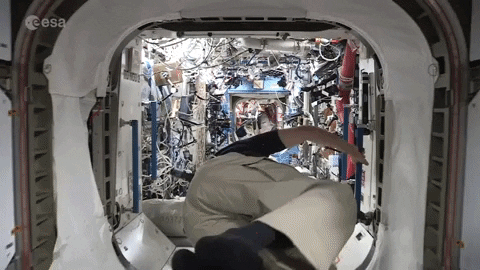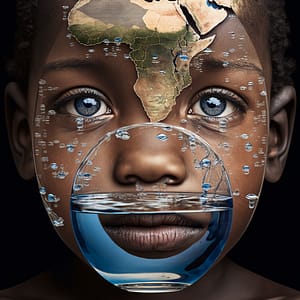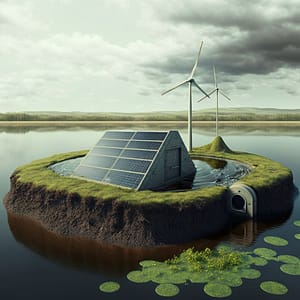There’s a treasure in the sewer, and we barely notice: wastewater and its pee and poo are an incredible source of water, energy, and a bunch of additional resources. Better: it could solve the World’s water needs and help balance the Zero Carbon energy equation. How? Let’s explore:
with 🎙️ Antoine Walter – Podcaster in Chief at (don’t) Waste Water
💧 (don’t) Waste Water is the Water Industry’s reference podcast pursuing this simple mission: Understand Water, Solve the World!
TED Talk: What’s the Value of Your Poop?
Table of contents
- TED Talk: What’s the Value of Your Poop?
- How do Spaceships deal with Water?
- We only reuse 4% of the Water on Earth
- Planet Earth has a 0.0075$ budget per Liter of water to Reuse. Is it enough?
- How much does it cost to reuse wastewater?
- Wastewater is Renewable Energy
- Wastewater Reuse can Feed the World
- Conclusion: Let’s reuse more wastewater!
- Other Episodes:
How do Spaceships deal with Water?
There are two inhabited spaceships in the Universe.
The first one is the International Space Station, which has many perks. Think of it:
- It offers a stunning view of the stars.
- It is equipped with the best human technology.
- It gets rid of boring things like gravity.

But the ISS also has a major drawback: it doesn’t have any natural resources. No air, and no water, unless someone brings some.
Water in the International Space Station costs 22’000$ per Liter
So every quarter, you have a new spacecraft at the door. Who’s that? John or Igor, depending on who’s turn is on, I’m here for the water delivery. Oh great, how much would that cost? Well, 22’000 dollars per Liter.
How much?!
Sure, that’s expensive! But it also makes sense. To bring that water up to the space station’s door, you have to build a rocket, gather a crew, plan and perform a launch, burn a gigantic amount of fuel and ultimately pay for John or Igor’s salary.
The ISS reuses 80% of its Water
Now the beauty of that is that I’m a water engineer. And with such a clear benchmark, I can dive into my process book and find out a way to produce water at a cheaper expense.
This is how, since the beginning of the international space station’s life, water has been reused, first at 60% and nowadays at 80%, thanks to upgraded technology.
What does that mean? Well, let’s say that an astronaut drinks a cup of coffee; he will ultimately pee a good portion of that coffee, that pee will get re-treated, and the next day he’ll somewhat drink the same coffee again!

Bottom line:
- We have all the technology it takes to run water in a circle.
- It’s safe and healthy.
- We can do it for much cheaper than 22’000 dollars a liter.
We only reuse 4% of the Water on Earth
So now, if we look at the second inhabited spaceship, also known as Earth. There’s something weird in the way its 8 billion crew deals with water.
Indeed, only about 4% of the water gets reused today – even though we’ve seen that we technologically can easily reuse 20 times more.
Maybe, that’s because we have plenty of water on the blue planet, and hence everybody already has their fair share of it!
If I was to poll you today, I’m pretty sure I would get that answer. Water? Yeah, we have water!
3 proofs we don’t have enough water, though
Yet, projections show that by 2030, we will be missing 40% of the water we need for our World to strive. Water to drink, water to irrigate our crops, and water to feed our industry.
By 2030 still, we estimate that 700 million people could be displaced by water scarcity. To give you a sense of scale, that’s ten times more than the second world war!
Finally, today, 2.2 billion people still don’t have access to a safe source of drinking water.

But if we have the technology to solve these problems, how can it be that we still face them?
Well, technology is one thing; finding the money to pay for it is another one.
So what would be Earth’s budget for one Liter of safe drinking water?
Planet Earth has a 0.0075$ budget per Liter of water to Reuse. Is it enough?
If you remember, the calculation to get to John or Igor’s invoice for the space station was simple: NASA added up all the costs and divided it by the number of liters to supply.
Thanks to Gary White and Matt Damon, we can actually do kind of the same for Earth.

Why “kind of”? Because the founders of Water.org have calculated what they called water’s coping costs. Basically, it sums up all the costs involved by the absence of safe drinking water.
Water’s coping costs: how much does it cost not to have access to safe drinking water?
People will have to walk around for hours to get to a water source; they will have to boil it; they will lose working hours or school hours to do so; they will still sometimes get sick and need care, and so on, and so on.
All of that together costs the World, every year, 300 billion dollars.
So let’s do the maths. We have a 300 billion dollars yearly budget, which we have to divide by 2.2 billion people without access to safe drinking water, who each need 50 Liters a day, 365 days per year.
This provides us with a budget of 0.0075 dollars per Liter. Or 0.75 cents per Liter.
Let’s make a side-by-side comparison.
A side-by-side comparison between water management on the ISS and water reuse on Earth
An astronaut on the ISS needs 0.5 Liter of water per day. A human on Earth, though, needs one hundred times more!
And while an astronaut’s budget per Liter is 22’000 dollars, an habitant of Earth only has 0.75 cents.
If we do the maths again, that’s a 300 million times smaller budget.
Houston, we have a problem!

So what can we afford for 0.75 cents per Liter? Well, let’s take the problem the other way around, what would we need to turn wastewater into drinking water?
How much does it cost to reuse wastewater?
First, you would need to screen the water, to remove the large floating things, then use a fine screen to remove smaller particles, oil, and grease, while some sludge gets sedimented and extracted from the bottom.
You then send your wastewater to bioreactors, where microorganisms break down organic matter, and then send your water to clarifiers to separate the microorganisms from the water.
At that stage, you have sludge on one end – and we’ll come back to that later – and treated wastewater on the other end.
That water is clean enough to be safely discharged to the environment, yet, it’s not potable yet.
After wastewater treatment, wastewater reclamation
So, if you want to turn that water into drinking water, you need to undergo a new process. You feed that water to a first ultrafiltration pre-treatment, then reverse osmosis, and finally, you disinfect it using ultraviolet.
Now, you can drink that water. And studies prove that this kind of water is of better quality than any other source of drinking water.
But I do get that even if perfectly treated, you maybe still don’t want to drink water that just went through your neighbor’s body. By the way, every molecule of water we have today, went through a dinosaur at some point. But arguably, that was a long time ago, that’s psychology, and I’m not arguing against it because I only have 14 minutes today.

And now, Drinking Water Production
So let’s do the following. We take that perfectly drinkable water, we mix it with some other good source of water, be it rainwater, river water, or groundwater, and we treat it again.
We take that water, we run a coagulation and a flocculation, then we remove large particles in a sedimentation, then we filter it, we disinfect it with a combination of ozone and activated carbon to remove any possible micropollutant, we finetune the water with Lime, Chlorine, Fluoride and Ammonia and now we serve it to your tap.
It already was the safest possible water; we still treated it a second time, so now the only question that can be left is: how much does it cost?
Will it fit our 0.75 cents per Liter budget?
Well, that entire treatment train costs 0.27 cents per Liter. How do I know? Well, that’s the exact process Singapore is using to reuse its wastewater and cover 40% of its water needs today and 50% by 2030.
So, with our 0.75 cents per Liter budget, we can cover three times the cost of wastewater reuse.
And that’s not the end of it.
Wastewater is Renewable Energy
We’ve seen how you can efficiently take water out of wastewater and potentially solve many issues. But if I take water out of the wastewater word, I’m left with just “waste.”
Yet all these things mixed with water are everything but waste!
That’s where it gets colorful. Ready?
A human produces 5 tons of poop in his life
On average, every human on Earth produces about 5 tons of poop over his lifetime.
You know, sometimes I wonder. How often have humans looked at the sun before realizing the energy value it has? How often have humans felt a wind breeze before realizing all the energy it represented?
So here’s an existential question. When you go to the toilet, do you look at your poop? And if you do, what do you see?
Well, exactly like the sun or wind, your poop is a source of renewable energy!

Zero Carbon by 2050 commands for Renewable Energies
And talking of energy, if we want to limit the effects of climate change in the next century, we know that we have to phase out fossil fuels like oil and gas with the vision to reach a global net-zero emission by 2050.
In 2050, we will be 10 billion humans on Earth, happily pooping 5 tons of shit each over our lifetime.
How much energy would that represent? Well, translated into clever wastewater engineer lingo, that pee and poo become chemical oxygen demand.
10 billion humans on Earth produce one million tons of chemical oxygen demand every day. And a series of studies conducted by Elisabeth Heidrich determined each gram of chemical oxygen demand to represent 16.1-kilo Joules of Energy.
I know you love maths, but I’ll save you the calculation details. Here’s the bottom line: that makes for 4’472 gigawatt-hour of energy every day and about 1’600 Terawatt-hour of energy every year.
Wastewater is Liquid Energy!
That’s the equivalent of 320 nuclear power reactors or 140 million tons of oil being burned in thermic power plants.
Just with pee and poo, just with our households, not even talking of the untapped pool of industrial wastewater!
But, there’s a but.
This energy really is in our wastewater, but we haven’t yet found the perfect treatment process to tap into it.
There are very promising prospects with:
Microbial Fuel Cells
See, for instance what Cambrian Innovation does:
Microbial Electrolysis Cells
A topic we’ve covered in the past with Aquacycl and Microrganic Technologies:
Supercritical Water Oxidation
And if you remember right, we’ve discovered SCWO with 374Water:
And interestingly enough, many of these technologies have been seeded by NASA – because mastering them would be very useful to life on the international space station, the moon, or Mars.
Yet, I can’t reasonably ask you for such a moon shot today.
Luckily, there’s a steady, proven technology that taps into some of this potential, and that’s already fully available today!
The Workhorse that enables to tap into Wastewater’s Energy: Anaerobic Digestion
That technology is anaerobic digestion.
What it does is pretty simple. It mimics your body’s digestion to turn some of the wastewater sludge into biogas. And that’s already pretty efficient for tapping into wastewater’s energy: depending on the studies and the technology you leverage, you can extract about 40% of wastewater’s chemical energy!
That’s already 56 million fewer tons of oil to burn every year: thank you, emoji Poo!
So, we’ve seen that wastewater reuse can cover your water needs and that it can support covering your energy needs. What else can it do for you? Well, it can feed you!
Wastewater Reuse can Feed the World
To feed the 10 billion people I just alluded to, by 2050, the World will have to increase its food calorie production by about 50%.
To do so, like it or hate it, we need fertilizers. And our wastewater contains ammonia and urea, which makes it a potentially great source of nitrogen-based fertilizers! We could actually cover 30% of the World’s needs just with what’s in our sewers.
In the same spirit, phosphorus is a mineral in finite quantity on Earth, heavily mined today in China and Kazakhstan, then sent around the World for a variety of applications, like, for instance, fertilizers. Well, our pee and poo could, for instance, fully cover our white phosphorus needs, and that’s not science fiction; it is currently rolled out in Germany.
And wastewater reuse can also unlock resource recovery
Well, if at that stage you’re still not convinced that there’s a treasure in your wastewater, let me be even more literal with rapid-fire examples. Industrial wastewater is rich in lithium, which we can extract and valorize in batteries!
We all pee about three liters of potassium every year – which we could sell for about 40 dollars.
Recovering the toilet paper we flush in our toilets would cover 7% of the World’s Pulp & Paper demand – so much fewer trees to be cut.
And there’s heat trapped in our wastewaters, which, if recovered and by my podcast guest Aaron Tartakovsky‘s count, could power all the electric cars on the road in the United States.
Let’s wrap up.
Conclusion: Let’s reuse more wastewater!
The water alone contained in wastewater justifies treating and reusing that wastewater. And if today, we only treat 56% of the World’s sewage and we only reuse a fraction of it, the rise of water scarcity will be a strong driver for adoption.
Even better, wastewater treatment plants can transform into water resource factories that produce not only water but also energy and a bunch of valuable raw resources.
That will not only support the decarbonization of our World, but it will also enable us to really enter into the new realm of a circular economy.
Water reuse is already well developed in certain areas
And that circularity exists at many scales, from the treatment unit in the building’s basement to the country-wide approaches in Singapore or Israel, through the city strategies in Los Angeles, or the community projects in India, Africa, or Brazil.
The beauty of the field is that there’s no right or wrong approach to reuse. As long you reuse.
Fast-forward to your next visit to the toilets. Look up your poo. That’s an investment, and if things are done the right way, you’re gonna see the windfall of it at some point!
Think of it before you flush.













4 thoughts on “What’s the Value of Your Poop?”